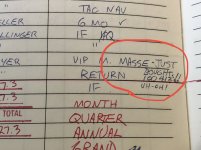PGM was pretty novel back then. US Hornets and Vipers didn’t have them either.
I recall reading the “US gave the RCAF PGM kits” part, but for the life of me I can’t find the article or recall where i saw it. Have you ever seen that in a CMJ or other article by chance?
This article eludes to an OP IRON SABRE but there is no "separate entry" for it on the website:
Historical information about the Gulf War.

www.canada.ca
Canada’s commitment to Gulf operations increased on 14 September, when the Prime Minister announced that the CF would provide a squadron of fighter aircraft to provide Combat Air Patrols (CAP) for the Canadian ships in the Gulf. These aircraft came from 409 Squadron in Baden, augmented by aircraft and personnel from 421 and 439 Squadrons. The last of the 16 aircraft arrived in Doha, Qatar on 12 October, through Operation SCIMITAR.
Two days later Canadian CF-18s began to conduct patrols in area Whiskey 2 - the Coalition fleet’s second line of air defence – and turned back an Iraqi two-aircraft patrol. Within two weeks, having by then figured out how they could be fully integrated into the US – led air defence scheme and operations, they replaced US Marine Corps F-18s patrolling in area Whiskey-1, a front-line sector. Further proof of Canadian capabilities came when they were tasked to provide CAP for the US Navy aircraft carrier Midway while it was transiting through the Straits of Hormuz. The carrier was prohibited from launching its own CAP while in the Straits.
The air force contribution was already well integrated into the coalition, but it would be increased to twenty-four aircraft and about 550 men and women. Pilots from 421 and 439 Squadrons in Baden and 416 Squadron in Cold Lake replaced the initial deployments.
The air war began the night of 16 January with the CF-18s flying CAP, in Whiskey – 1 and immediately raised the chance of blue-on-blue conflict when allied pilots returning from offensive operations entered the Canadian patrol area without having turned on their Identification – Friend – Foe (IFF) transmitters. All these aircraft had to be intercepted and positively identified as friendlies – at night, often with closing speeds of Mach 2 – and no mistakes were made. This CAP of Whiskey-1 was almost exclusively Canadian until 19 January, at which time the arrival of two more American aircraft carriers allowed the Canadians to reduce their flying hours.
Starting 20 January, the Canadians started “sweep and escort” missions. CF-18s would sweep ahead of a group of attack bombers to ensure that the area was clear of enemy aircraft. Other CF-18s would provide close escort to manage any threats that popped up after the sweep aircraft had passed. These missions were not without risk. The anti-aircraft fire over Iraq was intense; the Iraqi forces also appeared to have a surplus of surface-to-air missiles, many of which were spotted approaching Canadian aircraft. Luckily, the missiles dropped away at the last minute, falling short.
On 30 January two CF-18s were diverted to attack an Iraqi fast patrol boat that had managed to escape destruction by other aircraft. After two strafing runs with the CF-18s 20 mm guns, the boat was irreparably damaged and later found to have sought safe-haven in Iran.
In mid-February, plans were underway at National Defence Headquarters for the CF-18s to take on a more offensive role – attacking Iraqi targets on the ground.
To provide the necessary bombs, Operation IRON SABRE (see separate entry) was initiated on 22 February. Two days later the CF-18s conducted their first bombing run, dropping thirty-two Mk 82 500 lbs bomb, and it was intended that they would conduct between eight and sixteen sorties a day for up to thirty-two days. However, hostilities would end on 28 February, and as a result the CF-18s conducted only 56 bombing missions.
The CF-18s returned to Baden, with the last aircraft leaving Doha on 9 March.



